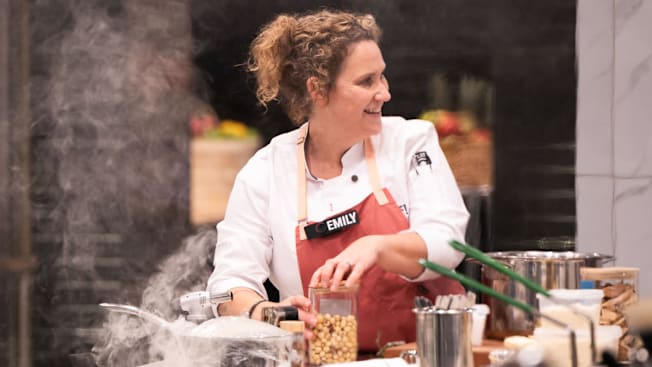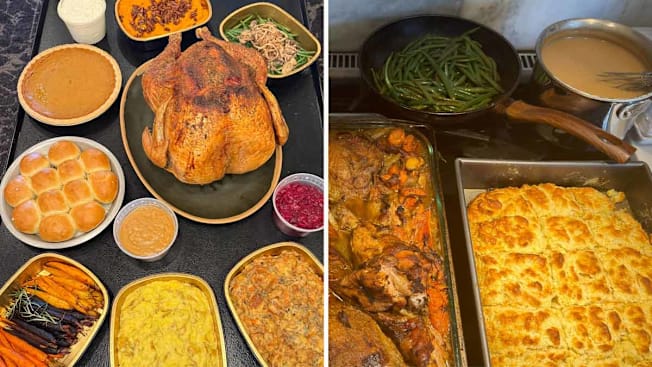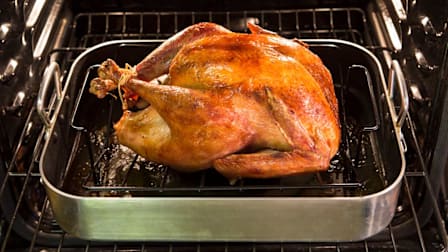A Pro Chef's Tips for Planning a Perfect, Stress-Free Thanksgiving
Chef Emily Brubaker, winner of "Yes, Chef!", shares her best tips and a holiday meal timeline
When you shop through retailer links on our site, we may earn affiliate commissions. 100% of the fees we collect are used to support our nonprofit mission. Learn more.

Before she picks up a chef’s knife, heats up a frying pan, or touches a single ingredient for Thanksgiving dinner, Emily Brubaker gets out her laptop, smartphone, smartwatch, and a pile of Post-its to immerse herself in the process of planning. Before even thinking about the actual cooking, she maps out what she needs to do and when.
“I have checklists and spreadsheets with what I need to buy,” she says. “I have a prep list of each recipe broken down: ‘What can I do early?’ and ‘What do I need to do on the day of the meal?’ ”
7 Days Out: Make a Plan
“I usually start with who’s coming, how many, and what allergies or dietary limitations there are,” she says, “because that’s going to dictate everything else you need to do. Once I know who’s coming, I can start figuring out what time I want to do the event. Is it like an afternoon affair? Is it an evening affair? Because we have kids, we usually eat about 6. So I know that it’s going to be a little bit more dinner style; the food needs to be a little heavier.”
As for those dietary preferences, Brubaker assumes she’ll have a vegan or vegetarian guest at the table. Which means she’ll find a couple of easy ways to make that person feel like they’re not just nibbling on side dishes.
The first step is to make a flavorful vegetarian stock with carrots, celery, onions, herbs (or what chefs call mirepoix), and maybe even some mushrooms for a little shot of umami. This can be cooked for as little as 45 minutes and frozen in advance. The meat-free stock allows for soups and stuffing to be vegetarian-friendly but still tasty.
She’ll also plan a festive vegetarian entrée. A particular favorite is a tiny delicata or honeynut squash that’s cut in half, roasted, and stuffed with, say, wild rice and pecans. “I get a little pomegranate molasses and just drizzle it over the top to give it a little zing and a rich depth of flavor,” she says. The tiny squash can occupy a place of honor on a vegan guest’s plate instead of turkey, while also letting the carnivores enjoy a smaller portion of squash as a side veg. “They’re really cute and absolutely delicious.”
6 Days Out: Gear Up
This is the time to get your kitchen under control. “I start with spring-cleaning my pantry, my oven, my refrigerator, and my freezer,” Brubaker says. “I like to make sure I’m organized and ready to go.”
Once you’ve spruced up your workspace, find the necessities you haven’t used since the last holiday: a large container to brine the turkey, a roasting pan stashed in the garage, a meat thermometer, and even your gravy boat. Brubaker will also pull out Post-its and label every single bowl or serving vessel with what goes inside: “This platter is for turkey,” and “This chafing dish is for mashed potatoes.”
Brubaker likes to calibrate her meat thermometer in advance by dunking it in ice water to see whether it reads an accurate 32º F or whether she needs to adjust her temperature readings. If you need a new meat thermometer, the $15 ThermoPro below is inexpensive, widely available, and sits near the top of our ratings.
During the week before the holiday, she’ll roast a chicken so she can understand if her oven is running a little hot or a bit cold, and by how much. She’s not a fan of convection ovens for cooking meat; she thinks that the fan tends to dry things out.
If you’re ordering a turkey, start your shopping early. Brubaker likes an organic brand called Diestel that you can find at many high-end grocery stores. But even if you’re content with a frozen store-brand bird, it’s still smart to buy early so you end up with one that’s the right size.
If you wait until three days before, you risk ending up with a 30-pound monster or a 7-pound bird that’s chicken size. How big should your bird be? “I do at least a pound-and-a-half per person,” says Brubaker, “which seems like a lot, but we love leftovers and we love sending food home.”
This is also the time to think about ordering baked goods. Is there a special bread you like for your stuffing? Call your favorite bakery now and put in an order. Are you a savory-only chef? Then find the best bakery in town, and put in an order for pies now—or have one of your guests do it—and you’ll have dessert covered.
5 Days Out: Do Your Big Shopping
With the turkey and desserts on order, Brubaker now plans that big trip to the supermarket, while it’s still well stocked and not crazy-crowded.
“The worst thing to do is shop for Thanksgiving during those three days before the holiday, because everything’s gone and you’re just stuck with what you find,” she says. “So I try to do my big shopping in advance, knowing what will last for a week. The potatoes are fine. Buying the mirepoix for the stuffing? Carrots, onions, and celery are fine. Salad mixes usually will be fine for a week.”
Fresh green beans? Not so much. Pick them up on your way home closer to the holiday.
This is also the time to consider applying an exotic spin to one of your mainstays, shopping for seasonings and ingredients you might not have in the pantry. “Instead of doing mashed potatoes, try a curried sweet potato. Or a tagine of couscous and lentils with apricots and almonds and cumin,” Brubaker says. “When you do a different type of side dish, it brings a whole new flavor experience to the family.”
This is also a good time to get some good-quality containers for your leftovers, like the ones from Ikea that were top-rated by our testers.
4 to 7 Days Out: Thaw Your Turkey
Thawing a turkey takes more time than you think. If you want to defrost it slowly in a cooler or your refrigerator, it’s going to take a few days, depending on the size of your bird. (Add 24 hours for every 4 to 5 pounds of turkey, our food experts say.) According to the Department of Agriculture, you can speed up the process a bit by leaving the turkey in its wrapping and submerging it completely in cool water in a sink or large container. Change the water every 30 minutes and be prepared to cook the turkey immediately after it has thawed.
This stretch of time is also a good opportunity to actually start cooking. For example, you can make cranberry sauce as much as a week ahead, because with so much sugar and the acid, it will keep. This is another time where Brubaker experiments with flavor and texture. This year, for example, she’s doing a brown sugar and bourbon recipe at the hotel. But a citrusy option with, say, blood-orange juice and lime zest is another alternative.

“The worst thing to do is shop for Thanksgiving during those three days before the holiday, because everything’s gone and you’re just stuck with what you find.”
3 Days Out: Brine Your Bird
Once the turkey is fully thawed, it’s time to brine it with ice water, salt, sugar, and toasted spices. To be safe, do this in your fridge. Don’t skimp on the time; your bird will be better if it’s brined for a full 24 hours.
While some recipes suggest moving the turkey straight from the brine to the oven, Brubaker contends that this skips a crucial step. She dries the bird thoroughly inside and out with paper towels and then puts it in the fridge lightly covered for as long as 24 hours. “The more you let the bird dry in your refrigerator, the more it dehydrates and loses its liquid,” she says. The result? A crispy, flavorful skin that rivals Peking duck.
This is also your cue to start your stuffing. “I like to precook all my vegetables before I put them in my stuffing. So I’ll roast or blanch my vegetables,” she says. Her go-to stuffing is rye bread, celery, and mushrooms, but stuffing is another perfect place to personalize your menu. It’s also the time to get out that vegetarian stock you made. “Stuffing needs to be fully saturated. Otherwise, you’ve got something that’s more like bread crumbs or croutons.”
If your knife skills are a little rusty and you need a primer on how to dice an onion safely, see the video below with a demo from Carolyn Moribito, an instructor at the Culinary Institute of America in Hyde Park, N.Y., and a professional caterer.
@consumerreports A great chef's knife is an indispensable kitchen tool, so it pays to know how to use it properly. Here's a quick how-to from Chef Carolyn Morabito of @Culinary Institute of America. Tap the link in our bio to see the best chef's knives based on our expert tests. #chefsoftiktok #kitchentok #foodtiktok
♬ original sound - Consumer Reports
2 Days Out: Set the Table
Once the bird is done brining, Brubkaker breaks it down. Literally. She’ll remove the legs and the wings, and cook them separately. “I like to braise my dark meat, because it makes a delicious gravy, and it keeps the dark meat super-duper moist,” she says. She’ll put the cooked turkey in a sealed container or a plastic bag with some of the drippings and store it until the big day. This is an optional step, but she says that it makes it easier to keep the white meat moist while ensuring that the dark meat is fully cooked.
This is also the time to do your heavy lifting, cooking-wise. “Anything you can just reheat, do it on Tuesday or Wednesday,” she says. “Make your mac and cheese and then just heat it up, so it gets that nice caramelized top.” It’s time to prep your green bean casserole, too. “Blanch your green beans. Make your béchamel. Find those crunchy little onions. Have it all ready to assemble.”
While many people view passing plates around as a holiday tradition, Brubaker serves her Thanksgiving meal buffet-style and suggests you consider doing the same. “I like to do a buffet rather than passing the food around the table because we always host so many people,” she says. “It’s less stress on the host and there’s more of that fun reveal, rather than everyone just watching someone carve the turkey.”
While most of us set the table almost as an afterthought, just before it’s time to eat, Brubaker says that doing it a couple of days in advance has a host of advantages. “I like the word ‘tablescape.’ Being able to bring the table to life with something other than the food is really fun,” she says. “And bringing everything out in advance brings that magical anticipation. It almost makes your stomach growl to see the table pretty and ready for the food.”
While setting the table a couple of days in advance gives you time to be artistic, it also gives you the opportunity to discover that, say, your best wineglasses need a lap through the dishwasher. “You know you’ve got the right silverware washed and every little bowl and dish is found, so there’s no scrambling,” she says.
She adds that a pretty table doesn’t have to be expensive: “It doesn’t necessarily need to be a giant flower arrangement. It could be fall leaves. It could be pine cones. It could be, you know, painted, anything.”

Photos: Emily Brubaker Photos: Emily Brubaker
The Day Before: Set Your Timers
“The magic of cell phones and smartwatches is setting timers,” says Brubaker. This step may seem a little like your day job, but she says it’s crucial in minimizing the guesswork on Thanksgiving Day.
“I draft a timeline and then sit there with my phone the night before and program in all of those timers. If I’m eating dinner at 6, I know I need to pull out my mac and cheese at 3 o’clock to let it temper for an hour before I want to throw it in the oven,” she says. “Yes, I’ll have 50 timers, but each one will be labeled with exactly what I need to do. Timer 1: Turn on the oven to this temperature. Timer 5: Put turkey in the oven. Timer 9: Baste the turkey …”
After the timers are programmed, she labels the serving vessels with what goes inside.
And even if you’ve been diligent with planning and cooking in advance, think of Wednesday as an opportunity to play catch-up. Set aside some time to review your menu, and prep and cook anything that’s not already done, besides, of course, the turkey breast.
Thanksgiving Day: Cook the Turkey—and Relax
“On Thursday, I start my day with a mimosa or Bloody Mary,” Brubaker says. “I’ll build the cold salad, put it back in the refrigerator. And then I can turn on the football game.” Aside from a few dishes, best done on the day of, like, say, charred brussels sprouts, all of your cooking should be done.
In the hours leading up to the meal, it’s a matter of listening for your timers and taking the food out of the fridge so that it comes up to room temperature (chefs call this tempering), and then popping it into the oven to heat up.
For actually cooking the turkey, Brubaker, who lives in California, likes to use a charcoal grill. “I have a Big Green Egg, so we’ll just slow-roast it and get a little bit of charcoal smoke,” she says. The advantage of cooking low and slow outdoors is two-fold. It frees up your oven space. And it alleviates the pressure in terms of precise timing. “You can put that breast on first thing and just forget it. You know that it’s going to take hours, so just set a timer to make sure the fire’s fed, and then you’re good. It makes the white meat so easy.”
Don’t forget to check the temperature with a meat thermometer midway through your cooking. (A turkey is done when a thermometer reads 165º F. Our food safety experts say that the pop-up timers on many turkeys aren’t always accurate.) If your turkey is cooking faster than anticipated, pull it away from the heat and tent it with some foil. If it seems like you’re behind, remove the breast from the bone to speed up the cooking. And remember to leave ample time—at least 20 minutes—for the meat to rest before serving.
And once the turkey is done but not dried out, and all of those amazing sides are heated up and on the table, it’s time to stop and enjoy a moment of gratitude with your guests. “My favorite moment of Thanksgiving is the silence after everybody’s gotten their plate and everybody’s eating, and it’s quiet around the table,” she says. “You know the food is good when you just hear forks and knives and the noise of the meal. That’s the part that makes my heart sing.”
For more stress-free holiday tips, check out this article on Your Thanksgiving Prep Timeline.
Entertaining With Ease
The latest episode of Talking Carts with Tanya Christian and Brian Vines




















